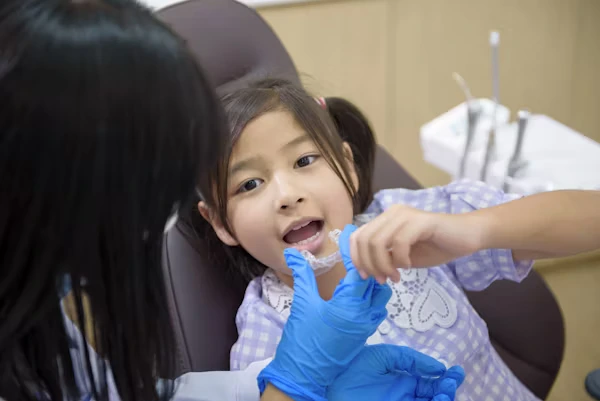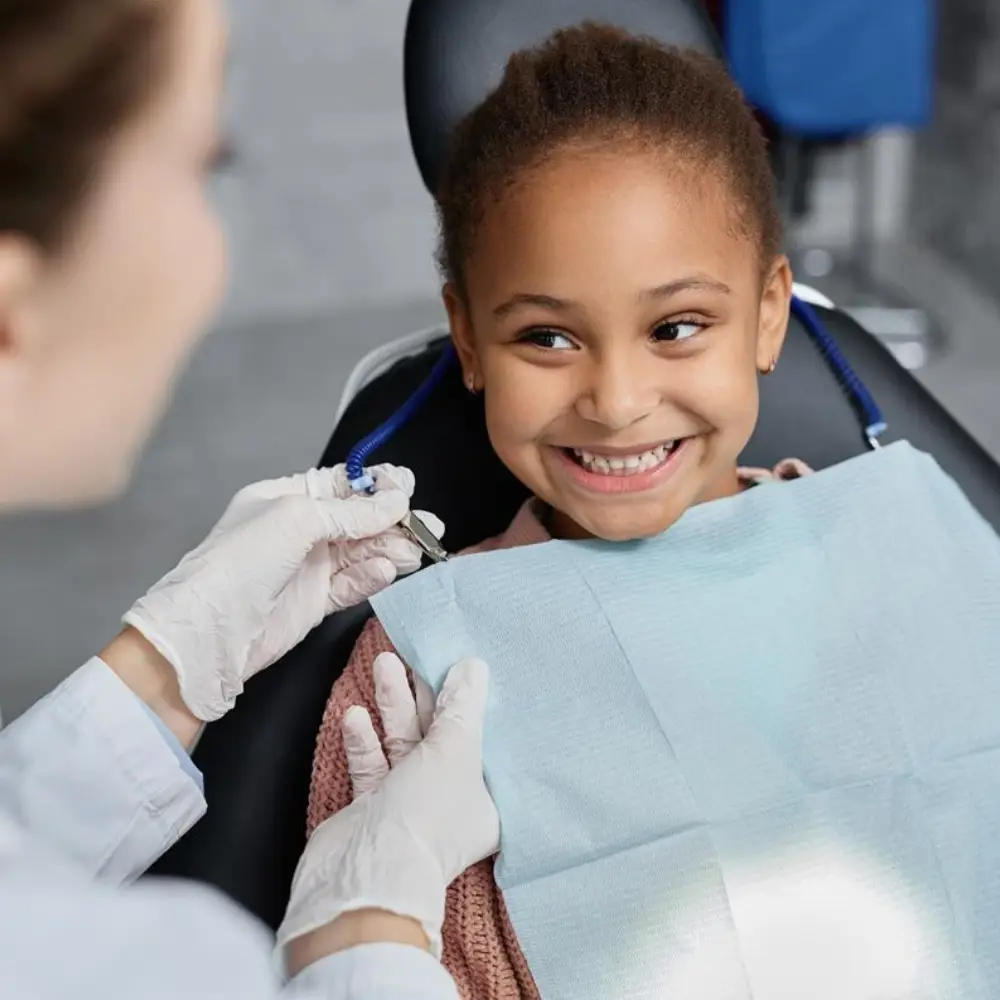Invisalign also fixes more than a straight smile; it fixes your speech as well. A considerable number of individuals are shocked when they are informed that crooked teeth and bad bite may influence clarity, pronunciations, and even self-confidence during a conversation. By using the Invisalign-smooth, barely visible aligners you can fix these problems without being noticed, and with no pain. No matter what you are preparing a big presentation or would just like to be more confident talking to people on daily basis, Invisalign is a win-win situation where you will not only have an even straight smile but also talk like a pro.
How Invisalign Affects Speech Patterns
Invisalign has worked wonders to straighten many people so that they can go ahead and smile but you know what, it can even affect the manner in which you speak. Since clear aligners shift the position of your teeth, they slightly alter the area necessary to the tongue regarding the sounds. Well-balanced bite structure and correctly aligned teeth are the point of departure to effective pronunciation and proud speaking.
During treatment, one is likely to develop a temporary lisp or slight slurring. Such modest changes typically have a temporary nature. Your mouth gets used to it with time and with practice and your speech comes back to normal usually with even more clarity since the positions of the teeth have been adjusted to provide the correct pronunciation.
Can Invisalign Improve Pronunciation and Clarity?

Crooked teeth may interfere in the ability to make some sounds. To draw an example people can have crowding, gaps or over bite interfering with sounds of s, sh, th and f. Invisalign gradually sorts these problems, straightening your teeth, so that the proper location and movement of the tongue are facilitated during the formation of speech.
When the result of a correction of your smile is achieved, patients note sharper pronunciation and improved intelligibility, not even making any strenuous efforts to train intonation and diction. These gains are particularly useful to speakers, singers, teachers and any other person in the verbal profession.
How Speech Issues Relate to Tooth Misalignment
A condition known as malocclusion, which is a lack of proper fit between your teeth, may limit tongue space. This can easily cause compensatory behaviors such as tapping the back of the teeth, moving tongue backwards or extending it excessively when pronouncing some sounds. These habits turn into a habit and can influence speech fluency.
Invisalign offers the best conditions to your tongue to find the natural resting and moving pattern just by aligning the teeth and correcting the bite. This lessens the requirement of compensatory speaking style and may bring permanent changes in speech quality.
Common Speech Challenges During Initial Invisalign Use
When the first aligners are added, they create a slight pressure and create a thin seal between your teeth and the aligner and this may have an influence on the tone of your voice. Temporary lisp is experienced by many individuals especially when saying “s”, “z”, and “sh”.
It is to be expected that there may be a little bit of saliva accumulation as your mouth gets adjusted, which may affect clarity as well. The advantage is that the majority of the patients get used to it in several days or a week. The transition can be quickened by simple exercises using repetition.
Why Invisalign May Be Better Than Braces for Speech
With orthodontic treatment, it is possible that using Invisalign is absolutely beneficial compared to using braces particularly in its impact to speech. Braces are usually accompanied by bracket and wires making tongue movements to be disturbed and may be associated with temporary lisps or difficulties during speech. However, Invisalign has smoother fitted and custom made trays that are placed over the teeth and the structure of your mouth adapts easily. This implies less interference to your pronunciation and less time to adapt. Since some people depend on clear communication, such as teachers, presenters, or any person facing clients, Invisalign presents a more speech-friendly approach without any issues regarding outcome.
Less Interference with Tongue Placement
Unlike the traditional braces, the Invisalign aligners are smooth and specifically fitted, therefore they have minimal interference into the natural mobility of your tongue. Beat that, Bulky brackets and wires, Invisalign trays fit neatly on the sides of your teeth and therefore cause little interference with speech. This will aid a number of users when they still retain clearer pronunciation even on the first few days of wearing them. This is especially in the case of people whose livelihood or self esteem depends on good communication. This has been very helpful in the case of many of the patients who actually adapt to speaking with Invisalign much quicker than they would have otherwise with metallic braces.
Fewer Obstructions Compared to Traditional Brackets
Braces present additional stationary obstacles in your mouth, which frequently prevent the flow of air and hinder the movement of the tongue. This may cause temporary lisp or mumbles. Conversely, Invisalign has transparent aligners that are slim and can be removed in contrast with metal braces which are very obvious. They are already easier to speak with since they do not contain sharp edges or wires that can fit close to your teeth. Numerous patients are grateful to the fact that the Invisalign fits perfectly within the patient appearance and the daily conversations.
Faster Adaptation for Adult Professionals
Adults, especially people in a profession, such as teachers, lawyers, and individuals working with clients, usually choose Invisalign as the option, since it does not affect speech as much. Its low profile construction is clear and makes it simple to even use it to talk with confidence, without being observed to alter articulation. Invisible braces (Invisalign) make the process of adjustment much quicker and natural, unlike massive metal braces. This makes them suitable to adults requiring to have an effective and clear communication at both personal and professional level.
Tips for Adjusting to Invisalign While Speaking
The Invisalign can take several days to get used to when speaking but most of the times it can be easily adapted with slight practice. At first glance you can see that you might sound slightly lispy or like you are incorrectly pronouncing the words, particularly the sounding of s and sh. This is totally natural and transitional. You will definitely have normal speech as your tongue adapts to the aligners. Reading, singing or rehearsing new words aloud may help making the transition quicker. Patience and confidence are a big assistant in the process of transitioning.
Speaking Exercises to Get Comfortable with Aligners
Mouth exercises Repeat the word or chant towels to train your tongue to go around the aligners. Also, read aloud the tongue twister script like “she sells seashells by the seaside” and whisper the tongue twister script as red leather, yellow leather. These easy exercises, which are done daily when the aligners are in place accelerate the process of adaptation and eliminate any speech irregularities.
How Long It Takes to Adapt to Talking with Invisalign
The improvement of pronunciation is noted within 2-7 days by most people, however, personal schedules differ. In case of any lisp or slurring that continues longer than two weeks, then the duration is normally mild lasting a short period of time. Articulation can be refined in other situations with the help of practice or a brief consultation.
When to See Your Dentist for Speech Concerns
Book an appointment in case there are speech problems that have prevailed within two weeks. It is possible sometimes that your provider may check the fit of your aligners- in some cases minor adjustments or even trimming may help. They may as well give specific speech suggestions or a speech professional referral in cases where there is a necessity.
Invisalign for Kids with Speech Delays: Is It Suitable?

In case of children who experience speech problems parents may be concerned with everything that will make communication more difficult. Invisalign, whose design is smooth and not noticeable, is at times preferred over braces even among children. In other situations, Invisalign can even be of assistance correcting bite problems hindering tongue motion. Nevertheless, one should collaborate with the orthodontist and the speech therapist of his child and make a decision whether it suits well his/her needs.
When Orthodontic Treatment Helps with Early Intervention
There are certain instances of difficulty of speech in children because of crooked teeth or incorrect bite. Healthy tongue positioning can also be assisted by early orthodontic advice (e.g., using Invisalign First) so that the tongue position is established when permanent teeth enter the mouth, which establishes the basis of speech development.
Speech Therapist and Dentist Collaboration Tips
When you have a child with a speech therapist, aligner use might be useful to overlap with therapy sessions. Most clinicians will advise resting between exercises or wear aligners that encourage the use of the tongues. Fluent communication between therapist and dentist will create the best results.
What Parents Should Know Before Starting Treatment
The parents ought to know that smaller children might require additional help with aligner disciplining, mopping, and talking training. The outcomes are based on adherence and one of the strategies used in inhibiting resistance was to frame the treatment process in terms of being a partnership than a correction process. Speech and dental benefits can be achieved with long-term care with early orthodontic treatment with proper maintenance.
Frequently Asked Questions (FAQs)
1. Will Invisalign cause a lisp?
A mild lisp is common during the first few days of wearing clear aligners, as your tongue adjusts to the new shape in your mouth. This is temporary and usually nothing to worry about. Practicing speech exercises, like reading aloud or repeating difficult words, can speed up the adjustment process. Most patients notice their speech returns to normal within a week or two, sometimes even sooner.
2. Can Invisalign actually improve speech issues?
Yes. By correcting alignment and bite issues that restrict tongue movement, Invisalign can remove physical barriers to clear pronunciation. Many users notice better speech quality once their teeth are properly aligned often with no need for additional speech training. As teeth shift into better positions, the tongue has more freedom to move naturally, improving clarity and comfort when speaking.
3. How long does it take to speak normally with Invisalign?
Most people speak clearly within a few days to a couple of weeks after starting Invisalign. The adjustment timeline varies depending on factors like bite alignment, tongue posture, and individual speech habits. A slight lisp or change in pronunciation is common at first but usually fades quickly. Practicing aloud especially reading or repeating difficult words can help your mouth adapt more efficiently. If speech changes persist beyond a few weeks, your orthodontist may offer tips or minor tray adjustments. With patience and regular use, most users regain clear, confident speech in no time.
4. Is Invisalign better than braces for people who speak publicly?
Yes. Invisalign’s smooth, clear trays create less interference with your tongue and lips than traditional metal braces, allowing for faster speech adaptation. Unlike bulky brackets and wires, the aligners fit snugly and comfortably over your teeth. Many professionals who rely on clear communication—such as teachers, speakers, or salespeople—choose Invisalign to minimize disruption. While a temporary lisp may occur, it typically resolves quickly with regular wear. The discreet design also allows you to speak confidently in public and professional settings.
5. Should I delay Invisalign if I already have a speech condition?
You don’t have to wait to start Invisalign if you have speech concerns. In fact, beginning treatment may help improve certain speech issues by correcting alignment that affects tongue placement. However, it’s a good idea to discuss your concerns with both your orthodontist and a speech-language pathologist. This team approach ensures your treatment supports both dental health and communication needs. Aligners are often considered a gentler, less intrusive option compared to traditional braces. With proper guidance, you can move forward confidently and comfortably.
If you’ve been waiting on straighter teeth, but worried about how braces might impact your speech, Invisalign offers a discreet solution that aligns both your smile and your voice. With minimal interference and guided support, you can move forward with confidence.
Ready to explore how Invisalign can refresh your smile and enhance your speech? Book a consultation today, try a demo set of aligners, and test your comfort with speaking exercises. Let’s work together toward a clearer voice and a brighter smile without missing a beat.


